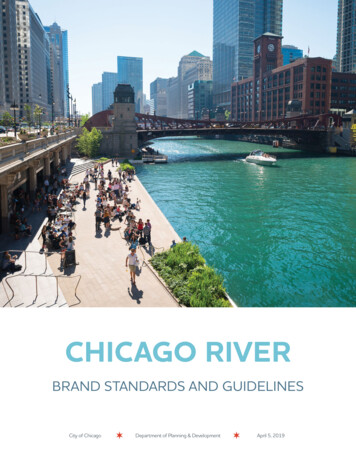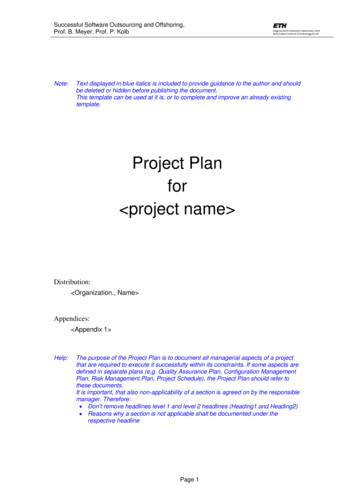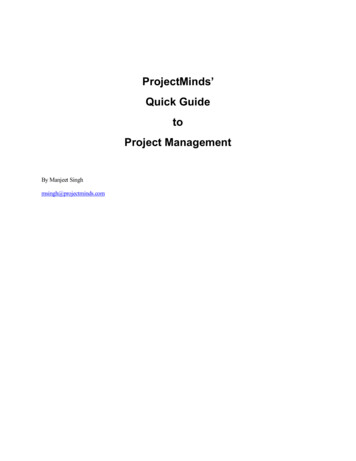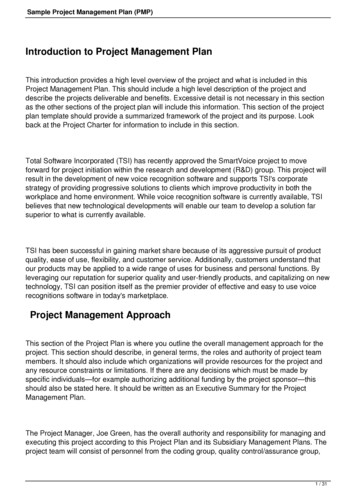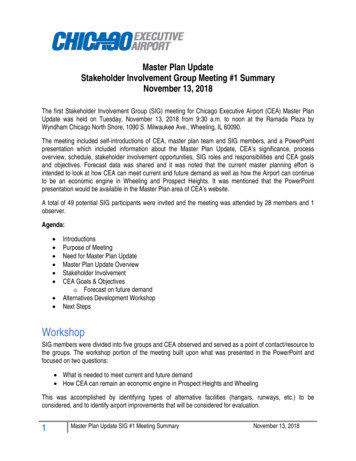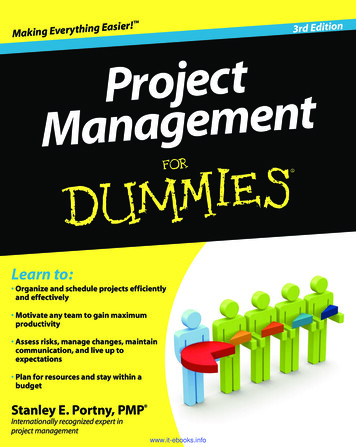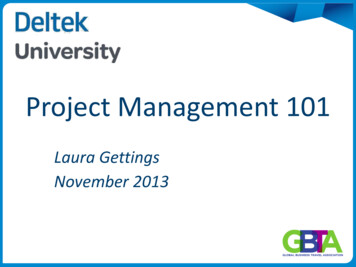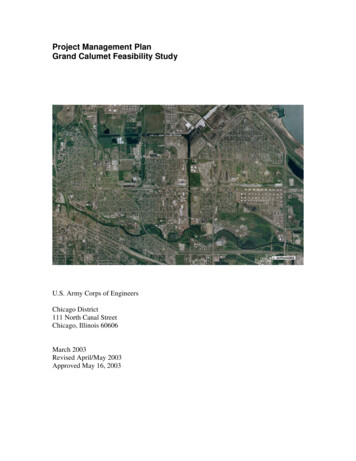
Transcription
Project Management PlanGrand Calumet Feasibility StudyU.S. Army Corps of EngineersChicago District111 North Canal StreetChicago, Illinois 60606March 2003Revised April/May 2003Approved May 16, 2003
JCH00 All Other Real Estate Analyses/DocumentsJD000 Environmental Studies/Reports/EISJDA00 Documentation of Scoping MeetingsJDB00 Environmental Impact Statement (EIS)JDC00 Coordination Documents with Other AgenciesJDD00 Environmental Resource Inventory ReportJDE00 Mitigation Analysis ReportJDF00 Endangered Species AnalysisJDG00 Ecosystem Restoration Alternative DesignJDH00 Section 404(b)(1) Analysis ReportJDI00 Statement of Findings (SOF)JDJ00 Other Environmental DocumentsJE000 Fish and Wildlife Coordination Act ReportJEA00 Coordination DistrictJEB00 Preparation of Coordination Act ReportJF000 HTRW StudiesJFA00 HTRW ReportJFB00 HTRW Remedial Investigation (RI)JFC00 All Other HTRW DocumentsJG000 Cultural Resource ReportJGA00 Site Survey Field ReportJGB00 Data Collection and Analysis ReportJGC00 Mitigation Plan ReportJGD00 Memorandum of AgreementJGE00 One Percent WaiverJGF00 All Other Cultural Resources Studies/ReportsJH000 Cost EstimatesJHA00 Study Cost Estimate UpdatesJHB00 PED Cost EstimateJHC00 Project Cost EstimateJHD00 OMRR&R Cost EstimateJHE00 Baseline Fully Funded Cost Estimate (MCACES)JHF00 All Other Cost EstimatesJHG00 Cost Engineering AppendixJI000 Public Involvement DocumentsJIA00 Public MeetingsJIB00 Minutes of Public Meeting(s)JIC00 Public Comments ReportJID00 – NewslettersJIE00 All Other Public Involvement DocumentsJJ000 Plan Formulation and Evaluation ReportJJA00 District Coordination MeetingJJB00 Establish Without-Project ConditionsJJC00 Preliminary Formulation and Screening of AlternativesJJD00 Alternative Formulation Briefing and ReportJJE00 Plan Formulation Management and 31313232323232333334343434343536363637383939394040
JJF00 Plan Formulation ConferenceJJG00 LRD Approves Formulation MaterialJK000 Draft Report DocumentationJKA00 Product Team (PT) ReviewJKB00 – Independent Technical Review (ITR)JKC00 – Feasibility Review Conference (FRC) DocumentsJKD00 Public Review CommentsJKE00 Project Guidance Memorandum (PGM)JKF00 All Other Draft Feasibility DocumentsJL000 Final Report DocumentationJLA00 Division Commander's NoticeJLB00 – All Other Final Feasibility Report DocumentsJM000 Washington Level Report ApprovalJMA00 Policy Review ApprovalJMB00 Chief's ReportJMC00 OMB Report ApprovalJMD00 ASA (CW) Report ApprovalJN000 All Other Feasibility Studies/InvestigationsJO000 Management DocumentsJOA00 Project Management Plan (PMP)JOB00 Acquisition PlanJOC00 A/E Contract DocumentsJOD00 Coordination DocumentsJOE00 Study Funds Control DocumentsJOF00 Trip ReportsJOG00 Minutes of Review MeetingsJOH00 All Other Management Documents and ActivitiesK0000 Project AgreementsKA000 Preconstruction Engineering and Design (PED) AgreementKB000 Draft PCAKC000 Federal/Non-Federal Allocation of Funds TableC. REFERENCE TO STATUTES, REGULATIONS, AND GUIDANCEIII.Work Breakdown StructureIV. Organization Breakdown StructureA. EXECUTIVE COMMITTEEB. PROJECT REVIEW BOARDS (PRB’S)C. PROJECT DELIVERY TEAM (PDT)Corps of Engineers, Chicago DistrictPlanning, Programs and Project Management Division (PM)Technical Services Division (TS)Office of Counsel (OC)Public Affairs OfficeContracting OfficeSupport Offices/OrganizationsInformation ManagementResource 85858
List of TablesTable 1Table 2Table 3Table 4Table 5Table 6Feature Alternatives for Analysis in theFeasibility StudyWork Breakdown Structure for GrandCalumet River/ Indiana Harbor ProjectPage 53Resource Codes for Feasibility StudyPage 63Page 6Responsibility Assignment Matrix for Grand CalumetRiver/Indiana Harbor CanalEnvironmental Dredging FS TasksPage 64Project Study SchedulePage 70Grand Calumet River/Indiana HarborCanal Environmental Dredging FeasibilityStudy Cost EstimatePage 74List of FiguresFigure 1Map of study area illustrating delineationof reachesvPage 5
I. Reconnaissance OverviewA. IntroductionThe International Joint Commission has listed the Grand Calumet River/Indiana Harbor Canal,since 1986, as an Area of Concern (AOC). This designation was based on impairments in 14beneficial use categories. A number of these use impairments can be directly attributed to thequality of the existing aquatic environment, specifically to the contaminated sediments.Impairments to wildlife, i.e. fish and waterfowl, as well as to recreational uses of the waterway aredirectly linked to the contaminated sediments. These heavily contaminated sediments continue to bea source of pollutants to the water column, while also providing a toxic environment for aquaticspecies and foraging wildlife. The Grand Calumet River basin is fairly typical in terms of degradedenvironmental quality resultant from decades of unchecked industrial and urban development.However, what is unique about this basin, are the potential impacts of restoration and remediationon the ecosystem. The Grand Calumet River Basin contains unique remnants of a once expansive(30,000 acres) dune and swale ecosystem adjacent to Lake Michigan. These remnants (about 2,000acres) provide habitat for 66 state rare and endangered species. Consequently, restoration of theaquatic habitat and adjacent dune and swale ecosystem will provide many benefits to the local floraand fauna.The Grand Calumet River system is comprised of the East and West Branches of the GrandCalumet River and the Indiana Harbor Canal and Lake George Canal. The East Branch extends 12river miles to the junction with the Indiana Harbor Canal, while the West Branch extends 4 rivermiles from the junction with the Indiana Harbor Canal to the Illinois-Indiana State line. Theupstream reach of the Indiana Harbor Canal is about 1.5 miles in length and the Lake George Canalextends about 0.5 miles. The flow regime of the river system is complex and driven primarily bylake level fluctuations in Lake Michigan, in addition to the many discharge and withdrawal pointsalong the river that are associated with the heavy urbanization/industrialization of this watershed.The purpose of the Grand Calumet River/Indiana Harbor Canal Environmental Dredging FeasibilityStudy is to investigate and recommend remediation alternatives, including dredging and disposal ofthe contaminated sediments in the Grand Calumet River and in the non-federal portions of theIndiana Harbor and Lake George Canals, Indiana, and ecosystem restoration within the riverchannel and adjacent areas. This Project Management Plan describes the tasks involved in thecompletion of the Feasibility Study, including the development of the appropriate study documents.The Chicago District, U. S. Army Corps of Engineers will conduct the Feasibility Study inconjunction with its non-Federal sponsor, the Indiana Department of Environmental Management(IDEM). Staff from the Corps of Engineers, Chicago District (Chicago District), or its contractors,and the Indiana Department of Environmental Management, or its contractors will perform the tasksdescribed within the Project Management Plan. The goal of the study is to develop animplementable project that meets federal, (including Corps of Engineers), state and local criteria.1
5
Table 1 - Feature Alternatives for Analysis in the Feasibility StudyReachNameMaxMinCappingDredging vertsHSDRoxanaRiver LocalizedWetlandDredgingXDisposal DisposalWetlandOptionRestoration Option#2#1/ XX
II.Scope of StudiesA. Feasibility StudyThe Feasibility Study is the second phase of the Corps of Engineers planning process, and follows afavorable Reconnaissance Report and execution of a Feasibility Cost Sharing Agreement (FCSA)between the Chicago District and the non-Federal sponsor. The purpose of the feasibility study is tofully evaluate all reasonable solutions to the problems identified during the reconnaissance phase.The Grand Calumet River/Indiana Harbor Canal Feasibility Study was authorized by Section 312 ofPublic Law 101-640 (WRDA 1990), Environmental Dredging. Section 312 authorizes the removalof contaminated sediments from federal navigation projects (Section 312 (a)) and in other, nonproject specific locations (Section 312 (b)). Guidance for implementation under Section 312 will beprovided by CECW-P/CECW-O, dated April 25, 2001.Future administration support for budgeting for possible implementation depends on an alternativebeing economically justified with high priority outputs. Benefits justifying a 312(a) project will bebased on cost savings associate with maintaining the existing federal channel. Efforts spent onevaluating recreation benefits may not add high priority outputs or administration support.Study AreaThe study area is located in northwest Indiana in the communities of Gary, East Chicago, andHammond, Indiana. The study area includes the non-federal upstream portion of the IndianaHarbor Canal, the non-federal upstream portion of the Lake George Canal, the West Branch of theGrand Calumet River to the Illinois-Indiana state line, the East Branch of the Grand Calumet River(excluding the U.S. Steel dredging project area), and the Lagoons. The Illinois portion of the GrandCalumet River, which extends 2.45 miles to the confluence with the Calumet River, is not includedin the study area.Study Goals and ObjectivesThe Chicago District and non-Federal sponsor (IDEM) have identified the following goal for theFeasibility Study: to remediate and restore the Grand Calumet River in accordance with the NaturalResource Damages Assessment Consent Decree developed between IDEM, Indiana Department ofNatural Resources, U.S. Fish and Wildlife Service, U.S. Environmental Protection Agency, andlocal responsible parties.Project Management Plan (PMP)The PMP for the Grand Calumet River/Indiana Harbor Canal Environmental Dredging wasdeveloped in accordance with the applicable Engineering Circular and Engineering Regulations.The Chicago District developed this PMP in conjunction with the non-Federal sponsor, IDEM. Thepurpose of the PMP is to present a plan for investigating, developing, and evaluating alternatives forremediating and disposing of contaminated sediments, restoring the ecosystem within the riverchannel and on adjacent areas, and improving water quality.7
This PMP describes the scope, budget and schedule of the tasks required to develop, initiate, andcomplete the Feasibility Study. A detailed work task description, cost-summary table, workbreakdown structure, division of responsibilities and preliminary schedule are included.Study ScopeThe Feasibility Study will produce a report, accompanied by an environmental document thatcomplies with the National Environmental Policy Act (NEPA). This report will provide all of thenecessary documentation to permit project authorization by the U.S. Congress for construction of aFederal project, if justified. The Feasibility Study will build upon existing information and look atthe watershed as a whole system and assess the potential for a multi-objective and environmentallyfriendly project in the study area. The feasibility phase consists of a study and development of aFeasibility Report to include:Problem IdentificationEvaluation and AssessmentReport PreparationProject AgreementsManagement and CoordinationThis effort is a partnership between the Chicago District and the non-federal sponsor (IDEM).Overall study management shall be the responsibility of an Executive Committee, which at aminimum will consist of members from the Chicago District and IDEM. Other agencies maybeadded to the Executive Committee if deemed appropriate after initiating the study. A ProjectDelivery Team (PDT) will coordinate on all matters relating to prosecution of the study. Thisincludes cost estimates, schedules, and prosecution of work elements, financial transactions, andrecommendations to the Executive Committee for actions to be taken on modifications to the PMP.The Executive Committee will either meet collectively or by other means of communication.The Executive Committee will manage the overall study by: (1) maintaining a working knowledgeof the feasibility study; (2) assisting in resolving emerging policy issues; (3) ensuring that evolvingstudy results and policies are consistent and coordinated; (4) directing the study management team;(5) rating decisions made by the study management team; and (6) maintaining authority overapproving budget variations.The PDT will consist of the designated team members for the Chicago District and the Non-Federalsponsor. The study will be managed within the Chicago District and will be accomplished underteam project management. PDT meetings will be held at 4- to 6-week intervals, but may be morefrequent at critical decision points.The PDT will consist of the following disciplines from the Chicago District: Project Manager, LeadPlanner (Planning Branch) or Technical Study Manager, Lead Engineer (Technical ServicesDivision), Real Estate, Contract Specialist, and Public Affairs. Chicago District’s Office ofCounsel, Resource Management, Information Management and Construction will be consulted asnecessary. In addition, the non-Federal sponsor’s designated representatives will be on the PDT.The PDT will coordinate activities with the respective product team members responsible fordeveloping the study in order to facilitate completion.8
During the feasibility phase, the team leader will be the Project Manager. The project manager willcoordinate with the members of the product team and will be the main point of contact with thePDT and Non-Federal sponsor. The project manager will make monthly progress reports to thePDT.Administrative and Technical Committees will also be established. The following technical subcommittees will be established:Hydrology, Hydraulics and Water QualityEcosystemDredging and DisposalPlan Formulation and EconomicsGeographic Information System (GIS)CommunicationsFeasibility Study ProductsThis Section of the PMP provides a definition of the products and a description of the tasks to beaccomplished during the course of the Feasibility Study. A complete listing of the tasks must beaccomplished in order to meet all Federal laws, statutes and policies. This PMP covers thedevelopment of four products prior (Feasibility Report and NEPA documentation, ProjectAgreements, Project Management Plans, and Other Supporting Plans) to the initiation of thePreconstruction Engineering and Design (PED) phase.Feasibility Report and NEPA compliance documentationThis includes all activities leading to the approval of the final Feasibility Report and appropriateNEPA documentation by the Chief of Engineers. It addresses in detail all of the goals andobjectives of the non-Federal sponsor and stakeholders. It entails all of the problem identificationand formulation activities required, and identification of a recommended plan for implementation.It will also include the appropriate NEPA and other environmental compliance documents. It willinclude an independent technical review by another Corps District, IDEM and possibly a non-Corpsagency; and policy reviews by the Great Lakes and Ohio River Division and Corps of EngineersHeadquarters for transmittal to Congress.The NEPA document, an Environmental Impact Statement (EIS) or Environmental Assessment(EA) will include all activities leading to the assessment of environmental impacts of the variousalternatives and recommended plan in compliance with NEPA requirements. These activitiesinclude scooping and preparation of the environmental document, coordinating the Fish andWildlife Coordination Act Report with U.S. Fish and Wildlife, public coordination and review, andnotification of findings. The alternatives analysis will investigate the positive and negative aspectsof alternatives proposed at the study area.Project AgreementsThe Preconstruction Engineering and Design (PED) agreement will be prepared and revised, asnecessary, to accompany the Feasibility Report and Project Management Plan (PMP). This9
agreement will include the PED cost estimate for all Federal and non-federal costs for PED from thedate of the Division Commander's Notice to the award of the first Federal construction contract.The Chicago District and the non-Federal sponsor will identify the PED activities and complete thecost estimate.As the details of the recommended plan are finalized, coordination will be undertaken with the nonFederal sponsor to review the language of the draft Project Cooperation Agreement (PCA) forconstruction of the project. Letters of Intent that acknowledges the requirements of the draft PCAand express good faith intent to provide those items for the recommended project will be developed.Additionally, the non-Federal sponsor will develop preliminary plans for financing their share of theproject costs. The Chicago District will then complete the assessment of these plans and an abilityto pay analysis. The coordination of the draft PCA and preliminary financing plans will becompleted in conjunction with the draft Feasibility Report.Project Management PlanThis PMP addresses the development of the Feasibility Study will be updated as necessary. Inaddition, a draft PMP for PED activities will be prepared based on the recommended projectidentified in the Feasibility Study, the baseline cost estimate and schedule for these activities.These activities include the design documentation report and preparation of plans and specificationsfor the initial construction contracts. The draft PMP will address the development of additionalproducts and more detailed plans for successful management and completion of the project. Thedraft PMP will be completed in conjunction with the Feasibility Report.Other supporting PlansOther supporting plans will be developed as needed as the study progresses to address specific itemssuch as local cooperation, real estate acquisition, quality control, value engineering, environmentaland cultural matters, health and safety, security, contract acquisition, and operation andmaintenance. The following supporting plans required for the study are attached: draft QualityControl Plan (Appendix A), Risk Based Corrective Action Process (Appendix B), PreliminaryDiscussion of the Site Safety and Health Plan (Appendix C), Communications Plan (Appendix D),Risk Management Plan (Appendix E) and Change Management Plan (Appendix F). It is importantto note that the communications, which will include an outreach program, needs to be developedearly in the process. The communication plan may be accomplished by using a District consultant.B. Task DescriptionsThe feasibility study will include the formulation of multiple purpose plans producing both NED(National Economic Development) and NER (National Ecosystem Restoration) outputs. An arrayof combination plans will be developed and compared to determine the tradeoffs (see ER 1105-2100, paragraph E-62.c.). The recommended plan will reasonably maximize the sum of net NED andNER benefits while achieving the best balance between the two objectives. Acceptability,completeness, effectiveness, and efficiency are the four evaluation criteria specified in the PlanningGuidance Notebook (ER 1105-2-100, paragraph 1.6.2)). Additionally, the recommended plan willbe economically justified (i.e. maximized net benefits or/and cost effective), environmentallysustainable, technically feasible, and socially and politically acceptable.10
The feasibility study will utilize a watershed study approach during the assessment of problems andopportunities. Existing studies will be used to lay the basis for the study investigation, which willlikely be focused on environmental restoration, recreation and navigation. Flood damages are not aconcern in this basin. A watershed resource management plan will be coordinated with the localstakeholders and when finalized incorporated into the feasibility study. The feasibility report willbe prepared in conjunction with appropriate regulations, policies and guidelines and will contain thesub-product descriptions listed herein.The various tasks to be accomplished are listed in the following paragraphs. In addition, thespecific tasks designated to each resource along with the corresponding estimated time and cost willbe listed in subsequent sections of the PMP.JA000 Engineering AppendicesEngineering Appendices will be prepared that provide detailed design and cost information tosupport the alternative analyses and the recommended plan. Each engineering discipline will becontributing an appendix. The Engineering Appendices will be prepared in accordance withapplicable design regulations and with ER 1110-2-1150. The Engineering Appendices shall containsufficient level of detail to allow the development of a defensible baseline cost estimate. TheEngineering Appendices will include the results of the feasibility phase design studies and analysesunder a wide array of disciplines. The detailed features of the Engineering Appendices are listed inthe following major and minor tasks.JAA00 Surveying and MappingJAAA0 Topographic and Utility SurveysExisting aerial and topographic survey data will be utilized if the data meets project study teamrequirements. Updated aerial and topographic survey data will be obtained where necessary. Allsurveying activities will be performed in accordance with EM 1110-2-1000, EM 1110-1-1003, ER1110-1-1003, and EM 1110-1-1005. In addition, utility data and real estate information will becollected for all project reaches where dredging, disposal or restoration is proposed for the project.The Chicago District’s Design Branch and their A/E contractor will perform the work.JAAB0 GIS Database & Mapping DevelopmentGIS database information for the Grand Calumet River Watershed from all available sources will becompiled in a GIS database. All new and existing data obtained for this feasibility study will alsobe included in the GIS database. New and existing data will include, but not be limited to, thefollowing information: sediment quality data, probing location, sediment thickness at probinglocation, water quality data, land use information, topography, municipal information, wetlanddelineation, real estate mapping, HTRW sites in the region, utility identification, and infrastructurethat may be impacted upon by dredging/disposal operations (i.e. bulkheading, bridges). The GISdatabase will be utilized in the design and analysis of project features. Development of the databasewill be coordinated with all appropriate Chicago District and non-Federal sponsor disciplines takingpart in the feasibility study. The non-Federal sponsor will manage the overall database, andPlanning Branch will take the District lead on this task.11
JAAC0 Sediment Probings & Hydrographic SoundingsDetailed sediment probings and hydrographic soundings have been carried out in the project reachesof the Harbor Canal, Lake George Branch, the East Branch Grand Calumet River, the West BranchGrand Calumet River and the Lagoons. The data will be entered in a microstation and Arc GIScompatible format.JAB00 Hydrology and Hydraulic Studies/ReportA Hydrologic and Hydraulic Engineering Appendix will be prepared that will include the results ofthe hydrologic, hydraulic and sediment transport analysis and modeling. The appendix will alsoinclude hydraulic structure analysis and design. Analyses will be completed in accordance with EM1110-2 1417, EM 1110-2-1416, EM 1110-2-4000, Hydraulic Design Charts, and computersimulation model manuals and practices. The appendix shall include a discussion of all data,models, model development, calibration, as well as stage and flow hydrographs and water surfaceprofiles. Updates to existing modeling are described in the following sections. The report willprovide detailed information about the model development and modifications related to this study –relying heavily on previously developed reports (i.e. SCRAP and TMDL). The appendix shall alsoinclude design details for hydraulic structures, including riprap-sizing analysis, as appropriate.Additional analyses shall be performed to develop a dredging plan. This analysis shall includeevaluation of dredged material quantity and quality, determination of the probability of risk factors(CSO and industrial spills) to be incorporated into the economic analysis, in additional to disposalarea and effluent treatment plant designs. A separate Environmental Engineering Appendix shall beprepared. Funding for this task is included in the costs for Task JF, HTRW Report.JABA0 Hydrologic ModelingJABAA Update Existing Conditions Hydrologic ModelingThe existing HSPF and SCALP models for the Grand Calumet River watershed will be updated toinclude currently available hydrologic data (i.e., rainfall, temperature, cloud cover, and solarradiation) and discharge data from industries and sewage treatment plants. Model calibration,previously accomplished for the SCRAP study will be discussed in the appendix but not redone.The model will be run for the extended period of record (Oct 1, 1991 – Sept 30, 2001).JABAB Future Conditions Sensitivity AnalysisAn assessment of potential impacts of future conditions on the watershed will be developed (i.e.,changes in land use/population) as a sensitivity analysis. Modification of model parameters will beaccomplished in order to provide future conditions hydrology in accordance with the futureconditions analysis. Data from dischargers will be adjusted by the same factors and an evaluationwill be performed to determine if all structures, etc. are appropriately sized for projected futureconditions.12
JABB0 Hydraulic ModelingJABBA Update Existing Conditions Hydraulic ModelingUpdated hydrologic data will be used to provide updated water surface profiles using existing HECRAS modeling. Model calibration, previously accomplished for the TMDL study, will berecollected in the appendix but not redone. The model was converted from UNET to HEC-RAS forthe TMDL study and recalibrated. Therefore, the baseline model will be the TMDL model of theGrand Calumet River and the calibration from that study will be used. New profiles will bedeveloped on the extended period of record (Oct 1, 1991 – Sept 30, 2001).JABBB Hydraulic Modeling Project ConditionsHEC-RAS modeling will be accomplished for both existing and project conditions. Projectconditions may include removal, partial removal, and/or some backfilling dependent upon otheranalyses such are structural, geotechnical, ecosystem, habitat, etc. A structural and stabilityanalysis will be performed by Geotechnical Engineering to estimate the impacts of sedimentremoval on the stability of existing structures, and the costs resulting from these impacts.JABBC Sediment Transport for Existing ConditionsSediment transport analysis to assess sediment movement in the Grand Canal River/Indiana HarborCanal will be considered after an economic analysis of potential advance maintenance dredging hasbeen performed. In the event that sediment modeling is necessary to complete the analysis, thePMP will be modified to include this additional effort. If included in the study, the existingQSNET modeling will be updated with the extended period of record hydrologic modeling. Thesediment transport/erodibility equations will be re-evaluated based on tests of the sedimentqualities. Results of the sediment transport modeling from the Grand Calumet River and upstreamreaches of the Harbor and Lake George Canals will be utilized to determine existing conditionsloading into the Federal portions of the Indiana Harbor Canal.JABBD Sediment Transport for Project ConditionsIf included in the study, the existing QSNET modeling will be updated with extended period ofrecord hydrologic modeling. Results of the modeling, in conjunction with the existing conditionssediment transport modeling, will be used to project the reduction in sediment transport into thefederal portion of the Indiana Harbor Canal under with project conditions. This information will beutilized for the economic analysis of the project.JABC0 Hydraulic Structure DesignJABCA Structure Design AnalysisDetailed analysis and design of hydraulic structures for maintenance of water levels will beaccomplished for each project reach during the detailed design phase. Structure analysis willinclude, but not be limited to, the following: weir design and analysis to maintain water levels,analysis and design of bank stabilization systems, including riprap sizing and placement design.The baseline feasibility cost estimate will be developed from previously completed structure designanalysis (SCRAP Report).13
JABD0 Hydrology and Hydraulic Alternative AnalysesJABDA Computer Simulation of Project AlternativesAs discussed under Sub-Task JABCA, hydraulic model simulations of project conditions will beperformed for the project alternatives. The results of the analyses will be used to evaluate theeffectiveness of the various alternatives.JABDB Future With-Project Conditions Hydraulic ModelingAs discussed under Sub-Task JABEA, hydraulic model simulations of future with-projectconditions will be performed for the project alternatives. The results of the analyses will be used toevaluate the effectiveness of the various alternatives.JABDC Sediment Transport Simulations of AlternativesAs discussed under Sub-Task JABCD, sediment transport model simulations of with-projectconditions will be performed for the project alternatives. The results of the analyses will be used toevaluate the effectiveness of the various alternatives. As noted previously, these simulations willonly be performed if it is dete
Project Management Plan (PMP) The PMP for the Grand Calumet River/Indiana Harbor Canal Environmental Dredging was developed in accordance with the applicable Engineering Circular and Engineering Regulations. The Chicago District developed this PMP
